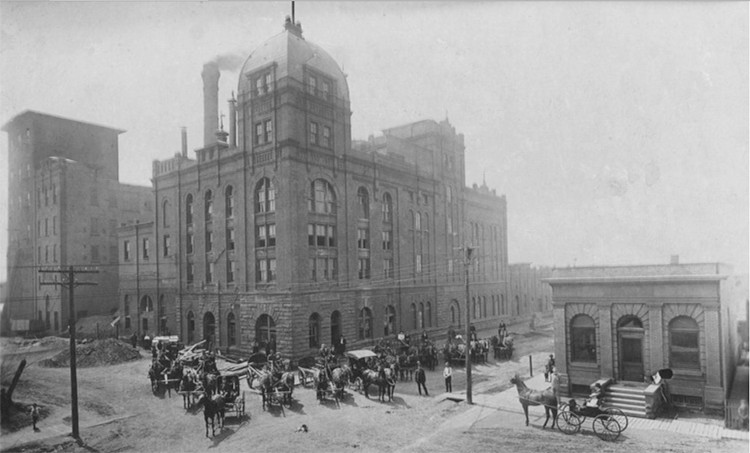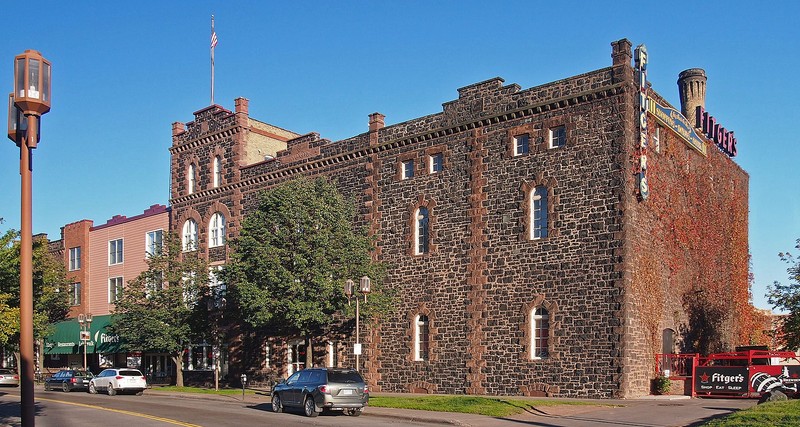Fitger's Brewing Company
Introduction
Text-to-speech Audio
Images
1893 photo of the main building what became a ten-building Fitger's Brewing Company factory by 1930

West end of Fitger's Brewing Company complex showing 1900 mill house (taller section), 1886 stock house 1, and 1899 stock house 2. Viewed from the west.

The former Fitger's Brewing Company complex, in Duluth, Minnesota, viewed from the northeast, in January 2016. According to the historic uses, the nearest building (with water tower atop it) was the Ice Machine building, to its left (with smokestack attached) was the Boiler House, and farthest back the Wash & Racking House.

Backstory and Context
Text-to-speech Audio
Duluth's economic and population boom experienced in earnest during the 1880s came with the opening of Fitger Brewing Company, the first commercial brewery on the western edge of Lake Superior. Operating from 1881 to 1972, the brewery served as Minnesota's oldest continuously operating brewery. The brewery's revival transpired in 1995 when Fitger's Brewhouse Brewery and Grille opened in the Fitger's facility in 1995, although it is much smaller in size than the original commercial brewery. The remaining portion of the historic brewing facility now hosts an indoor mall complete with shops, restaurants, nightclubs, a hotel, and a Fitger Brewing museum.
Duluth Township struggled mightily after the Panic of 1857, but a few visionaries remained like Sidney Luce, who decided to invest in a brewery. Luce leased property near a stream that flowed into Lake Superior (now referred to as Brewery Creek) near the location of the historic Fitger plant and hired four men, including amateur brewer J. Gottlieb Busch. Together, they produced the small town's first beers under the name, "Luce-Busch Brewery." Success for Luce-Busch, though, proved fleeting. The Civil War complicated Duluth's attempts to recover from the '57 Panic. When the war ended in 1865, Luce sold the struggling brewery to Nicholas Decker, who gradually turned the brewery into a profitable business.
Decker died in 1875, which led the remaining owners to sell the operation to Michael Fink in 1877. Fink renamed the brewery Lake Superior Brewing Company and developed sales agreements all of Duluth's eighteen saloons, which provided a significant boost to the brewery's success. The increased production pushed Fink to build a new facility in 1881. One year later, Fink hired August Fitger, a graduate of Germany's Weihenstephan Brewing School, who at 28-years-old served as Duluth's first journeyman brewmaster.
Fitger became half-owner of the brewery by 1883. With help from Percy Shelly Anneke, Schlitz Brewing Company auditor, Fitger attained full ownership of the brewery in 1885 and subsequently renamed it A. Fitger and Co. Lake Superior Brewery. The brewery grew substantially by the time of World War I, eventually producing more than tens of thousands of barrels per year, expanding from the one building constructed in 1881 to ten, and hiring an impressive number of employees.
However, like all liquor stories of the early twentieth century, Prohibition, World War II, and consolidation during the mid-twentieth century plays large in the Fitger story. Duluth residents voted for Prohibition earlier than the nation, approving it by 1917 (two years before U.S. Prohibition began in 1919). Fitger pivoted by producing everything from candy bars and soda pop, and did so with some success. Fitger's was one of the first breweries to bottle carbonated soft drinks and offer an array of flavors. Additionally, Fitger's bottling house profited so well from its sales of Lovit soda and a non-alcoholic mixer called "Pickwick" that Fitger renamed one of his saloons to Pickwick. Fitger also produced Silver Spray mixer that proved to be a favorite among those who looked to enhance the taste of bootleg liquors; the company distributed Silver Spray to thirty-one states.
Thus, despite losing money each year throughout the 1920s, the company managed to survive Prohibition. When the era came to an end, Fitger beer flowed again. In fact, 19,000 cases of Fitger beer departed the Duluth brewery for bars just after midnight of April 6, 1933. By 1940 they were producing 100,000 barrels a year and enjoyed sustained success for much of the 1950s and 1960s. However, substantial consolidation forced most regional U.S. breweries out of business by the 1980s (the nearly 4,500 breweries in 1890 sunk to less than 100 by 1983). Already struggling mightily, the grassroots environmental activism of the 1960s led to agencies requiring Fitger's to install equipment that would limit air and water pollution levels (notably into Lake Superior). This expense proved too much for the old factory. Thus, Fitger's closed its doors in 1972 after 115 years of brewing on Duluth's Lake Superior shore.
The brewery building survived a plan to demolish it in the 1980s when investors converted it into a hotel and retail complex that supported stores, restaurants, and a Fitger's brewery museum. And then, in 1995, coinciding with the dawn of the American craft-beer movement (that eventually saw brewery numbers pass the 8,000 mark by 2015), a group of owners leased part of Fitger's facility and opened Fitger's Brewhouse Brewery & Grille. Just as the original brewing story intertwined with economic downturns, the Civil War, corporate trends and Prohibition, the modern Fitger's -- at the time of this writing -- is enduring the financial hardships created by the COVID19 global pandemic.
Sources
"Beer Brewing." Zenith City Press. zenithcity.com. http://zenithcity.com/archive/historic-industry/beer-brewing/. Accessed August 18, 2020.
Fitger's Brewhouse. "Our Brewing History." Accessed August 18, 2020. https://fitgersbrewhouse.com/
Nelson, Charles W. "Nomination Form: Fitger Brewing Company." National Register of Historic Places. nps.gov. February 9, 1984. https://npgallery.nps.gov/GetAsset/bd997aa1-ea15-4896-a374-59947a08c6e9/.
Ogle, Maureen. Ambitious Brew: The Story of American Beer. New York: Harcourt Books, 2006.
Sommer, Lawrence J. Duluth: Sketches of the Past, a Bicentennial Collection. Duluth: American Revolution Bicentennial Commission, 1976.
Duluth Public Library via http://zenithcity.com/archive/historic-industry/beer-brewing/
By McGhiever - Own work, CC BY-SA 4.0, https://commons.wikimedia.org/w/index.php?curid=61624153
By David Wilson from Oak Park, Illinois, USA - 20160124 34 Fitgers, Duluth, Minnesota, CC BY 2.0, https://commons.wikimedia.org/w/index.php?curid=49267833
